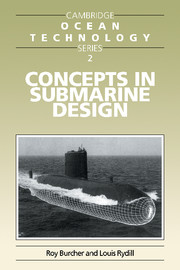Book contents
- Frontmatter
- Contents
- Introduction
- Acknowledgements
- 1 Design in general
- 2 Milestones in submarine history
- 3 Submarine hydrostatics
- 4 The weight/space relationship
- 5 Submarine structures
- 6 Powering of submarines
- 7 Geometric form and arrangements
- 8 Dynamics and control
- 9 Submarine systems
- 10 Considerations of building and costs in design
- 11 Generating a concept design
- Appendix 1 Hydrostatic conditions of flotation
- Appendix 2 Operational practice for keeping in trim
- Appendix 3 Assessing weight and size of variable ballast
- Appendix 4 Submarine pressure hull strength (Prediction of interframe collapse pressures)
- Appendix 5 Estimates of resistance and propulsion
- References and suggested reading
- Index
7 - Geometric form and arrangements
Published online by Cambridge University Press: 05 July 2014
- Frontmatter
- Contents
- Introduction
- Acknowledgements
- 1 Design in general
- 2 Milestones in submarine history
- 3 Submarine hydrostatics
- 4 The weight/space relationship
- 5 Submarine structures
- 6 Powering of submarines
- 7 Geometric form and arrangements
- 8 Dynamics and control
- 9 Submarine systems
- 10 Considerations of building and costs in design
- 11 Generating a concept design
- Appendix 1 Hydrostatic conditions of flotation
- Appendix 2 Operational practice for keeping in trim
- Appendix 3 Assessing weight and size of variable ballast
- Appendix 4 Submarine pressure hull strength (Prediction of interframe collapse pressures)
- Appendix 5 Estimates of resistance and propulsion
- References and suggested reading
- Index
Summary
INTRODUCTION
7.1 In preceding chapters we have touched in a rather piecemeal way on a number of considerations which bear on the choice of geometric form of a submarine and on the way in which its contents, both inside and outside the pressure hull, could be arranged to best effect. Our purpose in this chapter is to collect those considerations together and also to introduce several other issues associated with arranging the contents of the submarine.
In dealing with the matter of arrangements we will be addressing an aspect of the activities of the submarine designer which are what one might call architectural by nature. As we are both naval architects by profession we can take that description for granted our regret is that so much of a naval architect's time is taken up with engineering matters that he can be limited in the attention he is able to give to architecture. Yet it is an area of activity in which there is still scope as well as need for some art amongst so much science.
It might appear at first sight that the form and arrangements of a submarine present much simpler problems than those of a surface ship. Essentially a submarine is a long tube in which the disposition of most of its contents is arranged longitudinally with little scope for vertical variations. In a surface ship, on the other hand, with its multi-deck configuration, there is freedom for spatial interaction longitudinally, vertically and athwartships to be taken into account.
Information
- Type
- Chapter
- Information
- Concepts in Submarine Design , pp. 131 - 150Publisher: Cambridge University PressPrint publication year: 1994
